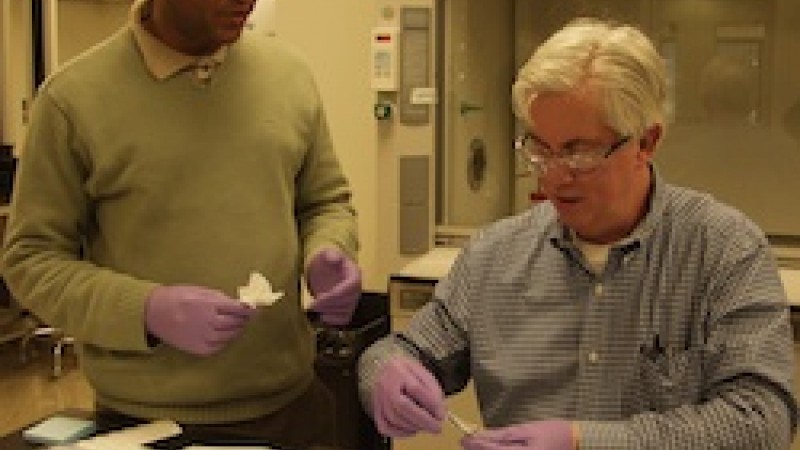Mike Crawford, a chemist at DuPont who’s a regular at SNS and HFIR, was the first outside user to take advantage of the new SNS second-floor laboratory suite. Crawford was preparing a PMMA (polymethyl methacrylate) thin film for examination on the SNS Backscattering Spectrometer (BASIS), loading a 100 micron thick polymer film into a sample can for placement in a cryostat.
The lab suite opened to users in November. Before the SNS labs were available, Crawford said, he had to borrow lab space in the Center for Nanophase Materials Sciences to prepare or examine samples. Having a fully equipped lab steps away from his user cubicle and a short stroll from the Experiment Hall is a distinct advantage.
The 13-lab complex was developed with input from a survey of users. The labs were designed with an emphasis on flexibility and mobility, with overhead utilities and movable furniture that experimenters can easily rearrange to accommodate different experiment configurations. They have both standard and nonstandard power outlets for instruments as well as multiple fume hoods for safe handling of solvents and other materials.
Crawford was at SNS in December to explore what happens to the dynamics of a PMMA film when silica nanoparticles are mixed into the polymer base. The sample was examined on BASIS at temperatures from 40 to 500 K (approximately −233 to 227°C). “We’re trying to see if the nanoparticles affect the backbone mobility (the diffusion of the backbone segments) and whether rotational motion of the methyl groups is affected,” he said. He is measuring several thin film samples with different polymer molecular weights to see if molecular weight has any effect on the dynamics.
His group at DuPont is studying typical nanocomposites—mixtures of spherical nanoparticles like silica, or plate-shaped and needle-shaped nanoparticles—with various polymers. There are claims that nanoparticles can dramatically improve the mechanical properties of polymers, he explained. “We’re evaluating some of these claims as well as doing fundamental research in the area of nanocomposites.” The experiments are aimed at gaining a microscopic understanding of the mechanical properties of the nanocomposites and then using that insight “to understand how to make better materials without trying everything,” he said.
PMMA is a common polymer used in dozens of products. “PMMA and polstyrene are the archetypes of amorphous polymers,” Crawford commented. He is also looking at polystyrene nanocomposites.
He also conducted measurements at HFIR’s General Purpose SANS instrument to explore the effect of nanoparticles on the molecular structures of the films.





